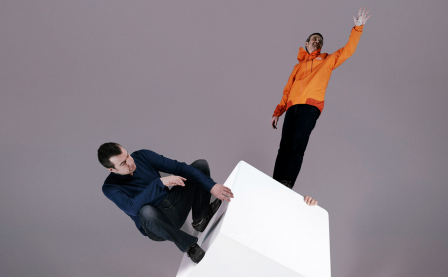In Alessandro Baricco’s novella Silk, the Japanese silk-baron Hara Kei keeps a giant aviary in his courtyard, “containing an incredible number of birds, of every species: a spectacle.” According to our hero, Hervé Joncour, who plans to construct a similar building in le Grand Sud-Est français, “you fill it up with birds, as many as you can, then one day when something good happens to you, you throw it open and watch them fly away.”
Given its beautiful typefaces, obscured titles, and muda na mono packaging, it’s immediately apparent that, with Scintilli, Plaid have lost none of the post-human playfulness that has helped distinguish their 20-year shift at the coalface of designer breaks. Indeed, for some, a mere glance at this album-object will induce micro-reveries of pleasantly skittering breaks mottled with puckish phrases, of bucolic digressions within almost-Balearic plateaux of post-Detroit ambience. What a pleasure, then, to discover that with age has come not just refinement, but a quiet sense of risk. As with Hara Kei’s aviary, Scintilli’s arrival heralds an explosion of f/light, the wings of this wind-up menagerie wheeling spokes of color in the dark.
Bum-notes are rare; the squarewave wobble and half-step orthodoxy of, respectively, “Somnl” and “Founded” are but superfluous concessions to mainstream models that already sound tireder than the jerky post-electro chatter of “African Woods” and “Eye Robot.” More impressive by far is a trio of collaborations with the machines of Felix Thorn — autonomous steampunkish devices generating music box twinkle and gamelan c/langour via electrified piano hammers. The toybox turnarounds and scattered tones of “Missing,” “35 Summers,” and “Craft Nine” flicker dainty hooks like call-notes, each referring devotees back to earlier works: as if these melodies were virions accumulated in the process of building that weighty backcat. Elsewhere, “Talk To Us” is a career highlight, rave-tension triggered in acicular phrases espaliered against throstled pans and swoops.
We can, I think, start to divide Plaid’s discography into distinct phases. The first period — the 90s — would circumscribe the duo’s departure from Black Dog Productions and their gradual abandonment of every alias other than Plaid. It was in the 90s that they elaborated the ideas and themes that would both mark them out and burden them during the creatively-disappointing slog of their second period, when Double Figure and Spokes pursued a harder, clubbier sound — as if some demented god had surveyed Detroit techno in its entirety and decided the only thing worth keeping was the whooshing noises. In the transition between the two phases, an anti-aliasing effect is discernible (an effect reflecting UK dance music production trends in general): the sped-and-chopped breakbeat science of UK hardcore, immanent from the first (jejune) attempts at hip-hop and house through to the reification of drum and bass, receding against a tide of filter-swept arpeggi and ultra-compressed digital kicks. A third period of retreat, beginning with Greedy Baby, has found Plaid seeking renewal in collaboration: not with artists, but with media. Grand, synthetic sculptures have featured heavily in Plaid’s past: they could never be accused of lacking a sense of scale. However, the sense of space, doubtless acquired through their forays into soundtracking discrete visual events, is something new. There is a poise about Scintilli in its strongest moments that was absent even from those early blazed trails.
More about: Plaid




